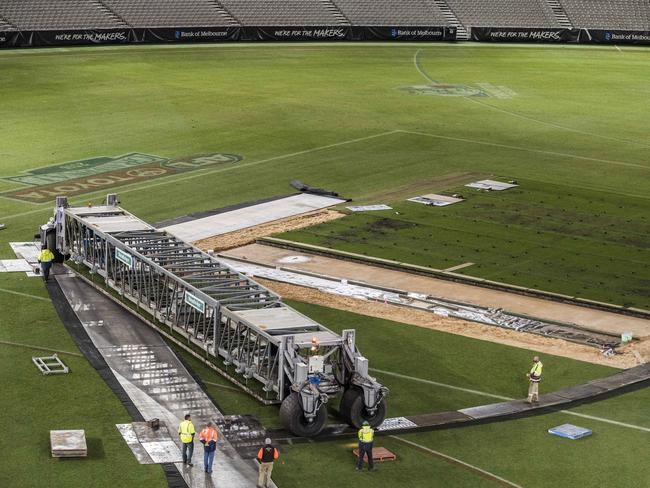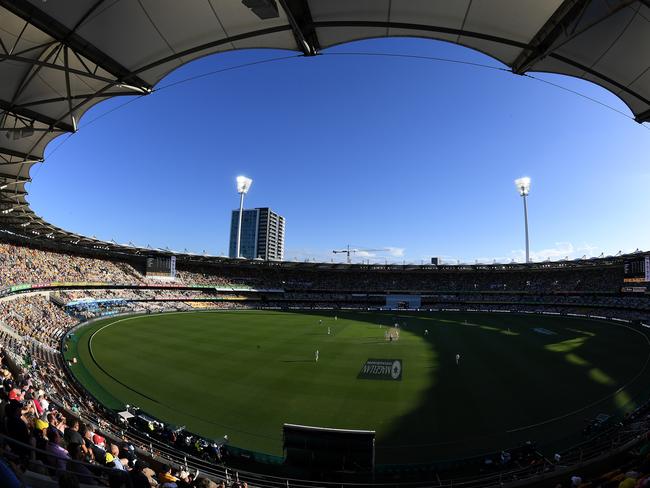The politics behind the cricket drop-in pitch debate and what it means for Australian grounds
The Gabba gets knocked down in a couple of years, and the debate about whether it should retain its natural centre wicket or follow the lead of the MCG, Adelaide Oval and Perth Stadium by bringing in drop-in pitches rages on.
Cricket
Don't miss out on the headlines from Cricket. Followed categories will be added to My News.
Something in it for the quicks early, flattening out to allow batters to cash in before deterioration on days four and five.
It’s the old recipe for a great Test pitch, and for years the Gabba has had a reputation for having all the right herbs and spices.
It’s not a coincidence though. Tony Hemming is something of a pitch whisperer, working on preparing international wickets across the world for more than three decades including stints with the Melbourne Cricket Club, Perth Stadium, The Oval and as the ICC’s head curator in the UAE.
Now consulting for the Bangladesh Cricket Board, Hemming says there is an empirical reason behind the Gabba’s long-term status: its clay content, which at 78 per cent is a global standard bearer.
“I’ve produced WACA pitches in Dubai and I’ve produced Gabba pitches in Dubai, and I felt the Gabba was the best soil I ever worked with,” Hemming told this masthead.
“It’s pretty simple. If you look at cricket clay, you just want to have 20 centimetres or eight inches of clay. And if you think of it just being a solid block of clay and when you go to prepare the pitch you want the top four inches of clay to dry out and be hard and you want still moisture retained underneath. All those that are unable to get enough moisture underneath struggle to when the pitch dries out.”

Test cricket in Brisbane is about to reach a crossroads though. While authorities are hopeful last summer’s two-day Test between Australia and South Africa was merely an aberration, potentially more lasting change is coming when the Gabba gets knocked down in a couple of years after the 2025 Ashes Test for its Olympic reconstruction.
Where in Queensland Test cricket could be staged in the three summers following is a source of intrigue, but more pertinent to the long run is the debate about whether the Gabba should retain its natural centre wicket post-facelift or follow the lead of the MCG, Adelaide Oval and Perth Stadium by bringing in drop-in pitches.
The discussion around drop-ins is an emotional one. It is more than just about how a wicket might play across the course of the season. At the heart of the issue is a power battle between cricket and football codes – primarily Australian rules – over what is the primary purpose of the playing surface.
The traditionalists, including Queensland Cricket’s leaders and SCG curator Adam Lewis suggest that a drop-in cannot fully match a natural deck.

“I love the characteristics of the SCG. You won’t get the perfect looking wicket like a drop-in wicket, you’re going to have your bare patches here and there, and I think that gives more character to the game,” Lewis said.
“I like a bit of difference.”
Facing a massive financial shortfall while bumped out of the Gabba during its redevelopment, Queensland Cricket – via chair Chris Simpson and chief executive Terry Svenson – wrote an open letter in July stating the case to retain a centre block.
“Advice from Cricket Australia and leading cricket curators is that their experience on similar pitches has shown that at least five years is required to be confident a pitch could be used for international cricket in the longest form of the game – five days for a Test match,” Svenson and Simpson wrote.
“The most recent instance of a drop-in pitch being employed for Test cricket matches in Australia was at Perth Stadium. In that instance, the time frame to establish a suitable nursery location and have a pitch fit for purpose to host a Test match was almost five years.
“Financial risks associated with previous drop-in pitch performance means extensive quality control is now required to ensure pitches meet certain standards for international cricket.”
Drop-ins were getting a bad name half a decade ago.
The MCG was the first to head down the drop-in path in the mid-1990s, but a couple of decades down the track the Merri Creek soil in the old tray was as benign as a pimple, leading to the nadir of the 2017 Boxing Day Test.

Yet six years on and after investment from the Melbourne Cricket Club and diligent work from curator Matt Page, the nation’s largest stadium is winning regular plaudits for creating compelling Test wickets.
The same can be said of Damian Hough in Adelaide, while Isaac McDonald’s wicket in Perth this summer had plenty of spice.
For those venues, having drop-ins looks like a no-brainer given the load of AFL matches played on the grounds and the flexibility it provides for the lucrative concert circuit.
And the Sydney Swans and Brisbane Lions have both been perennial advocates for the same path to be followed at the SCG and Gabba respectively.
While a likely Australia-West Indies mismatch is not the best litmus test, the Adelaide Test serves as a rare opportunity to see what Hough and his team can conjure in more conventional conditions given this will be the first time in more than five years that Adelaide Oval hosts a Test without the influence of pink ball and lights, widely believed to be favour bowlers.
Henning’s view is that drop-ins can perform as well as natural pitches, so long as the curator is skilful.
He also puts forward something of a left-field view for the new-look Gabba.

“If you’re building a new venue, and you’re going to be multipurpose then a portable pitch is going to be the obvious answer. You’re not going to have an international soccer team come out and say, ‘Oh, that’s fine. We understand cricket. We’re gonna play on it’. If you’re building a stadium, you’ve got no choice but there is new technology in the world that could do things differently. And I’ve looked into that,” Hemming said.
“I’ve got two ideas. If you sat with the architect you could put a cricket pitch on skates. And you could have a concrete slab running out to the middle and you’ve got three trays to get to the middle. So one tray is 25 metres in length. The outfield tray for the football would be 25 metres so you’d have three of those to get to the boundary line, 75 metres. And you get to have a car park under the seating so it opens up one pitch slides out. You could take one pitch out at a time. Now that’s very possible. Then you’ve got Real Madrid football stadium which stacks their whole football pitch underground, like car park stacking, and you’ve got grow light technology. So there is so much state of the art out there, but the trick is you’ve got to sit with an architect before he puts that button on print.”
Henning has concerns more broadly about the global pitch landscape, querying the ICC’s lack of funding and the impact of impulsive commentary from greats of the game.
“A curator doesn’t have the voice in the international game,” bemoans Hemming.
“I prepared a perfect pitch in Dubai. And I’ve got Sunil Gavaskar up there, commentating and the first ball bowled, bowler puts a seam across the fingers and delivers the first ball and the ball skids through, ‘oh it’s a fast wicket,’ and then the next ball he does the same thing but it hits the seam and it keeps low, ‘oh the wicket’s inconsistent bounce.’ So that’s as simple as it is.”
Originally published as The politics behind the cricket drop-in pitch debate and what it means for Australian grounds



